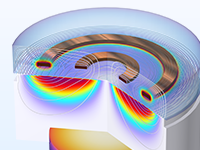
誘導性結合プラズマ
ICP 反応器において, 電力がプラズマにどのように結合するかを解析.1
低温プラズマ放電をモデル化
プラズマとは, 流体力学, 反応工学, 物理動力学, 熱伝達, 物質移動, および電磁気学が関与する重要なマルチフィジックス 系です. プラズマモジュールは, 幅広い工学分野で発生する非平衡および平衡放電をモデル化するための COMSOL Multiphysics® に特化したアドオン製品です. 任意の系を扱うために開発されたプラズマモジュールには, 直流 (DC) 放電, 誘導結合プラズマ (ICP), マイクロ波プラズマ, 容量性結合プラズマ (CCP), およびコロナ放電をモデル化するための定義済み設定が用意されています. COMSOL へお問い合わせ
さまざまな電磁波励起を受けるプラズマの挙動をシミュレート.

ICP 反応器において, 電力がプラズマにどのように結合するかを解析.1
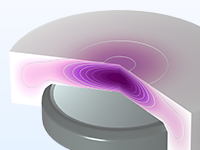
時間周期定常状態を直接求解する専用インターフェースを使って, CCP 反応器をモデル化.
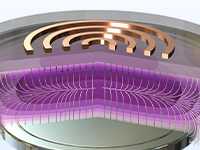
Investigate how an inductively coupled RF bias influences an ICP reactor.1

Couple a plasma model with fluid flow and heat transfer.
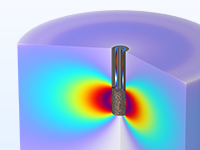
プラズマモデルと磁場, 電磁波を組み合わせ, ECR プラズマ源をモデル化.1,2
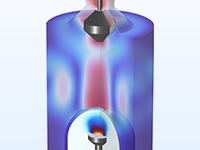
プラズマ中のマイクロ波加熱の影響を解析.2
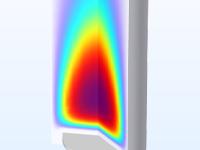
DC 電圧または電流によって持続する放電をシミュレート.
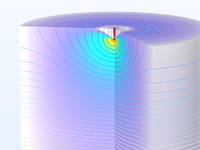
コロナ放電における荷電種の空間分布を計算.
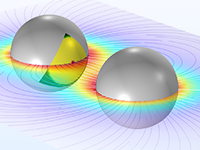
高電圧 DC 系が気体絶縁破壊を引き起こすかどうかを検出.
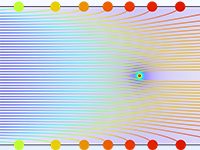
電気集塵装置の荷電粒子軌道を追跡し, 透過確率を計算.3
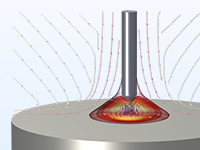
プラズマアークと周囲の材料の温度分布をシミュレート.1
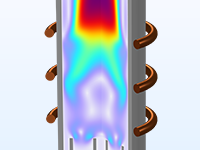
ICP トーチの電気的, 熱的特性を大気圧下で解析.1

ボルツマン方程式を含む, 高速なパラメーター化と複雑な化学反応に対応するグローバルモデルを使用して, プラズマ反応器をモデル化.
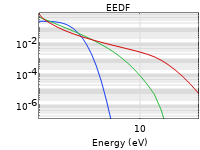
EEDF を計算し, 流体プラズマモデルで使用するための電子輸送パラメーターとソース項を計算.
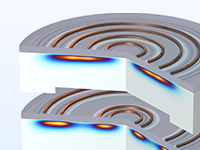
プラズマの均一性を得るために, ICP リアクターのコイル設計と配置を最適化.4
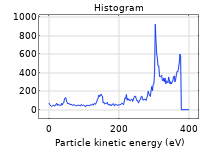
表面でのイオンエネルギー分布関数を計算.3
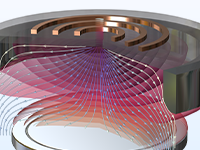
Simulate etching and growth rates along a surface.
プラズマモジュールは低温および熱プラズマをモデル化するための専用ツールを提供します.

プラズマモジュールは, 静電場または時間電場によって維持される低温プラズマ反応器をモデル化するための組み込みのユーザーインターフェースを搭載しています. これらのインターフェースはそれぞれ, ドメイン方程式, 境界条件, 初期条件, 事前定義されたメッシュ, 定常および過渡解析のソルバー設定による事前定義されたスタディ, および事前定義されたプロットと計算値のセットを定義します. すべての化学種 (電子, イオン, 中性粒子) の輸送方程式は, ポアソン方程式で自己無撞着に求解されます. また, 電子の平均エネルギー方程式は, 電子が電場からエネルギーを得て, 背景ガスとの衝突でエネルギーを失う方法をモデル化することによって解くことができます.
プラズマ化学は, 現実的なシミュレーション結果を得るために非常に重要です. プラズマモジュールを使用すると, 電子衝突反応, 重化学種間の反応, および表面反応を定義することができます.
プラズマ化学は, 背景ガスとの衝突で電子がどのようにエネルギーを失ったり得たりするかを決定します. プラズマモジュールは, 電離, 励起, および付着につながる電子衝撃反応をモデル化するための専用機能を提供します. 電子衝突反応は断面データから定義でき, ソース項は電子エネルギー分布関数を適切に積分することで得られます.
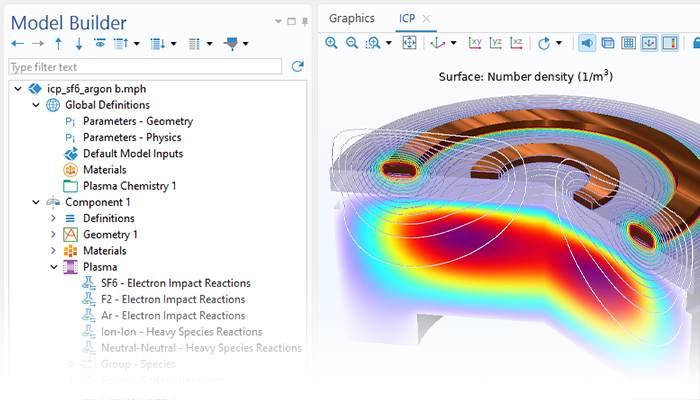
誘導性結合プラズママルチフィジックスインターフェース1は, 誘導電流によって維持される放電を解析するために使用されます. このマルチフィジックスインターフェースは, プラズマインターフェースからのプラズマ伝導率を磁場インターフェースに接続し, 誘導電流による電子加熱をプラズマインターフェースに結合します. 磁場は周波数領域で, プラズマは時間領域で解かれます.
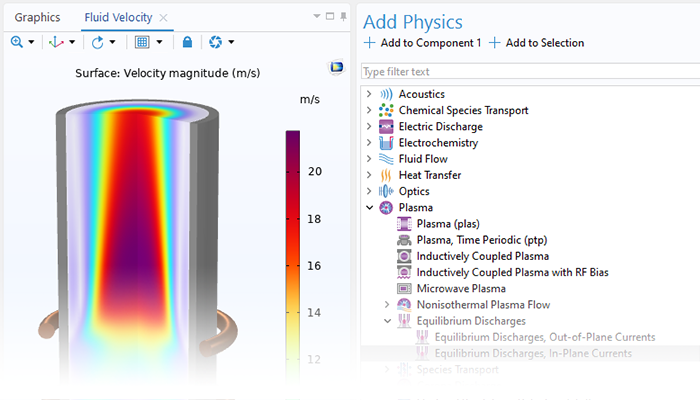
プラズマモジュールには, 熱力学的平衡状態におけるプラズマをモデル化するためのインターフェースが含まれています. 熱力学的平衡では, 電子と重化学種は同じ温度を持ち, プラズマは単一の温度で特徴付けることができます. このような条件のプラズマをモデル化するために, プラズマモジュールには, 電気的励起のタイプに基づいたいくつかの平衡放電インターフェースが用意されています. 平衡 DC 放電, 平衡誘導性結合プラズマ1, および複合誘導/DC放電1です. これらのインターフェースは, 磁気流体力学的アプローチにおいて, プラズマを1つの温度を持つ単一の流体として記述します. 平衡放電インターフェースは, 流体の流れ, 熱伝達, 磁場, および電流のインターフェースを結合したものです. プラズマフィジックスは, 特定の熱源を流体に組み込むマルチフィジックスカップリング機能によって, および電気伝導率, 熱容量, 輻射熱伝達などのプラズマ特性を介して導入されます.
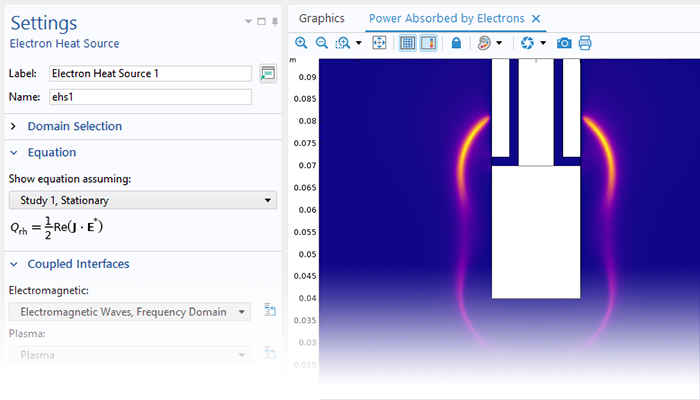
マイクロ波プラズママルチフィジックスインターフェース2は, 電磁波によって維持される放電 (波動加熱放電) を解析するために使用されます. このインターフェースを選択すると, プラズマインターフェースと電磁波インターフェース, およびマルチフィジックスカップリングが自動的に生成されます. プラズマ伝導度結合機能は, プラズマ伝導度を電磁波インターフェースに結合し, 電子熱源機能は, 結果として生じる電子加熱をプラズマインターフェースに結合します. 電磁波は周波数領域で, プラズマは時間領域で解かれます.
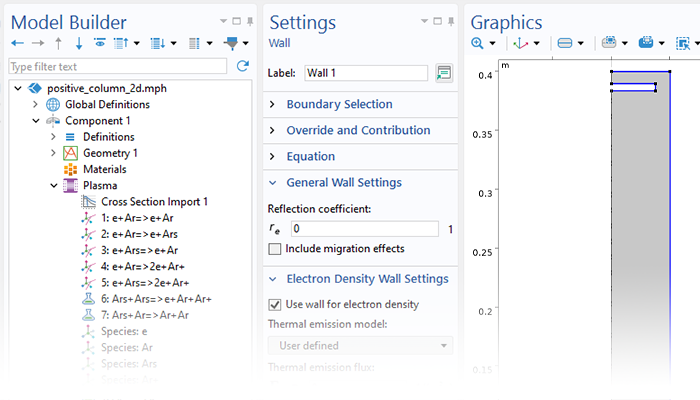
プラズマモジュール内の組み込みユーザーインターフェースの一部として, プラズマが表面とどのように相互作用するかを記述するためのさまざまな境界条件が用意されています. たとえば, 表面での電子密度とエネルギー流束は, 壁機能を適用することで簡単に定義できます. この機能により, 電子伝達方程式に輸送による損失が導入されます. 表面での二次電子放出や一般的な電子流束などの追加の流束源を含めることができます.
荷電粒子の流束は電極で自動的に計算され, 外部回路をモデル化するために追加できます. 誘電体がプラズマと接触している場合, 表面での荷重種の流束から表面電荷蓄積を計算することができます.
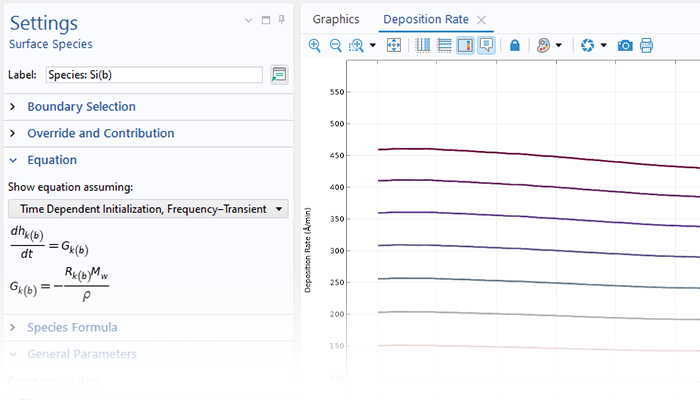
The Plasma Module includes a range of functionality for modeling etching and deposition processes in semiconductor fabrication processes. It solves plasma transport equations fully coupled with surface reaction kinetics, enabling the dynamic exchange of species between the surface and the gas phase. Surface site occupancy models can be used to accurately capture self-limiting reaction mechanisms. Furthermore, surface reaction rates can be specified with energy-dependent reaction yield models, facilitating detailed simulation of mechanisms such as ion-enhanced etching and energy-selective surface modifications.
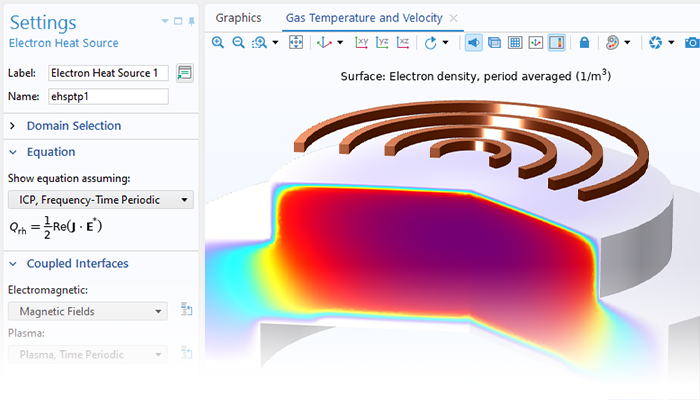
The Inductively Coupled Plasma with RF Bias interface1 is used to study discharges that are sustained by induction currents and by an RF bias. This multiphysics interface connects the plasma conductivity from the Plasma, Time Periodic interface to the Magnetic Fields interface and couples the electron heating resulting from the induction currents back to the Plasma, Time Periodic interface. The magnetic field is solved for in the frequency domain and the plasma is solved for in the time domain.
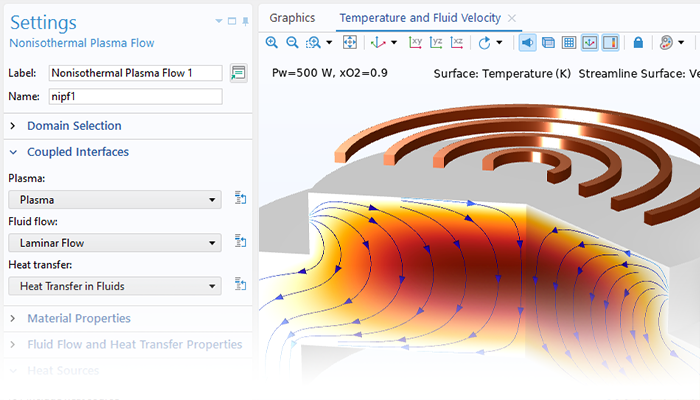
The Nonisothermal Plasma Flow interfaces combine plasma, fluid flow, and heat transfer interfaces to model background gas flow and heating in a plasma reactor. The heat transfer in the materials surrounding a plasma can also be simulated. The Nonisothermal Plasma Flow multiphysics feature automatically computes the heat source resulting from plasma reactions and inputs it into heat transfer interfaces as a volume heat source. Fluid and thermodynamic properties like viscosity and thermal conductivity are computed in the Plasma interface and passed automatically to fluid flow and heat transfer interfaces.
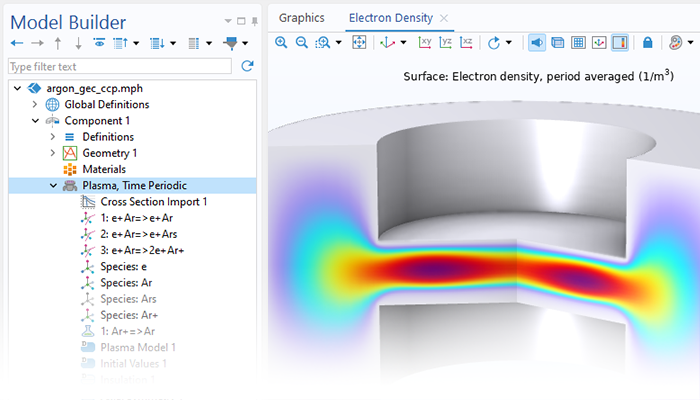
プラズマモジュールには, 従来の方法よりも大幅に短縮された計算時間で CCP をモデル化するための特殊な数値的方法が搭載されています. 時間領域で解く代わりに, 基礎となる数学方程式に追加の次元を追加することにより, 周期的な定常状態の解が計算されます. この追加の次元の方程式は, 1つの RF サイクルを表し, 周期境界条件を適用します. これにより, 何万, 何十万ものRFサイクルを解く必要がなくなり, プラズマが周期的な定常解に到達するまでに長い時間がかかることが避けられます. このアプローチは, モデルのすべての非線形性を維持しながら, 計算時間を劇的に短縮してくれます.
どのビジネスもシミュレーションニーズもそれぞれ違います.
COMSOL Multiphysics® ソフトウェアがお客様のご要望を満たすかどうかをきちんと評価するために, 我々にご連絡ください. 我々のセールス担当と話をすれば各個人に向いたお勧めや, しっかり文書化されたモデルなどをお送りすることができ, 最大限の評価結果を引き出すことができます. 最終的にどのライセンスオプションがあなたの要望にとって最適かを選択することができます.
"COMSOL へコンタクト" ボタンを押し, あなたの連絡先詳細と特別なコメントや質問があればそれを記入して, 送信していただくだけで済みます. 1営業日以内に我々のセールス担当者から返事が届きます.
ソフトウェアデモをリクエスト